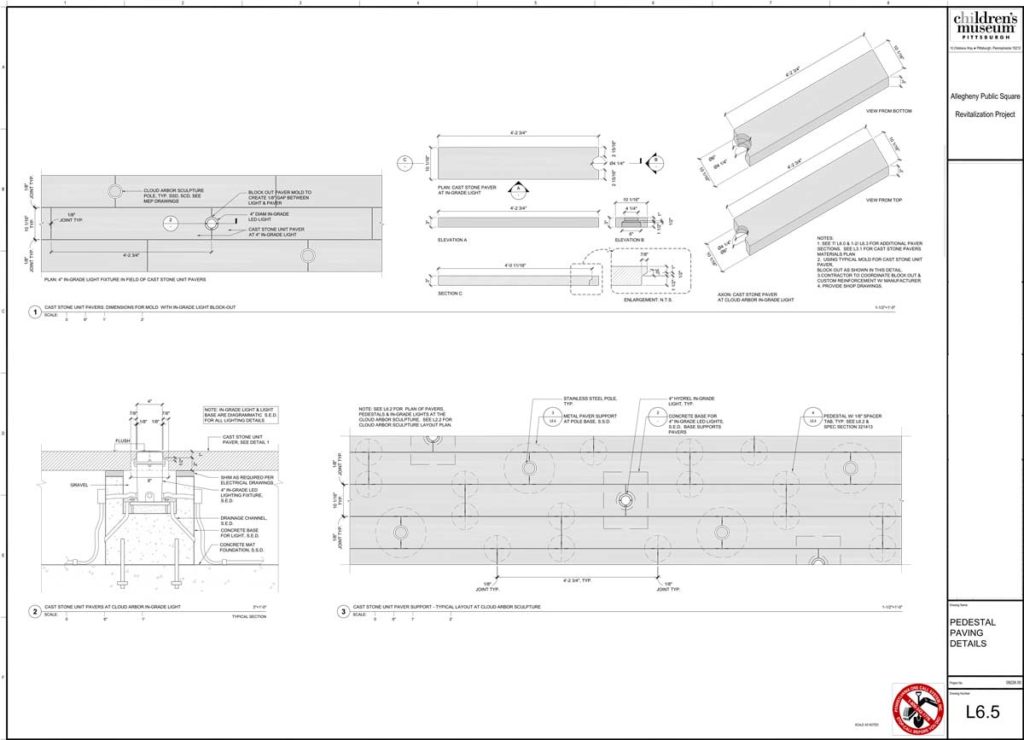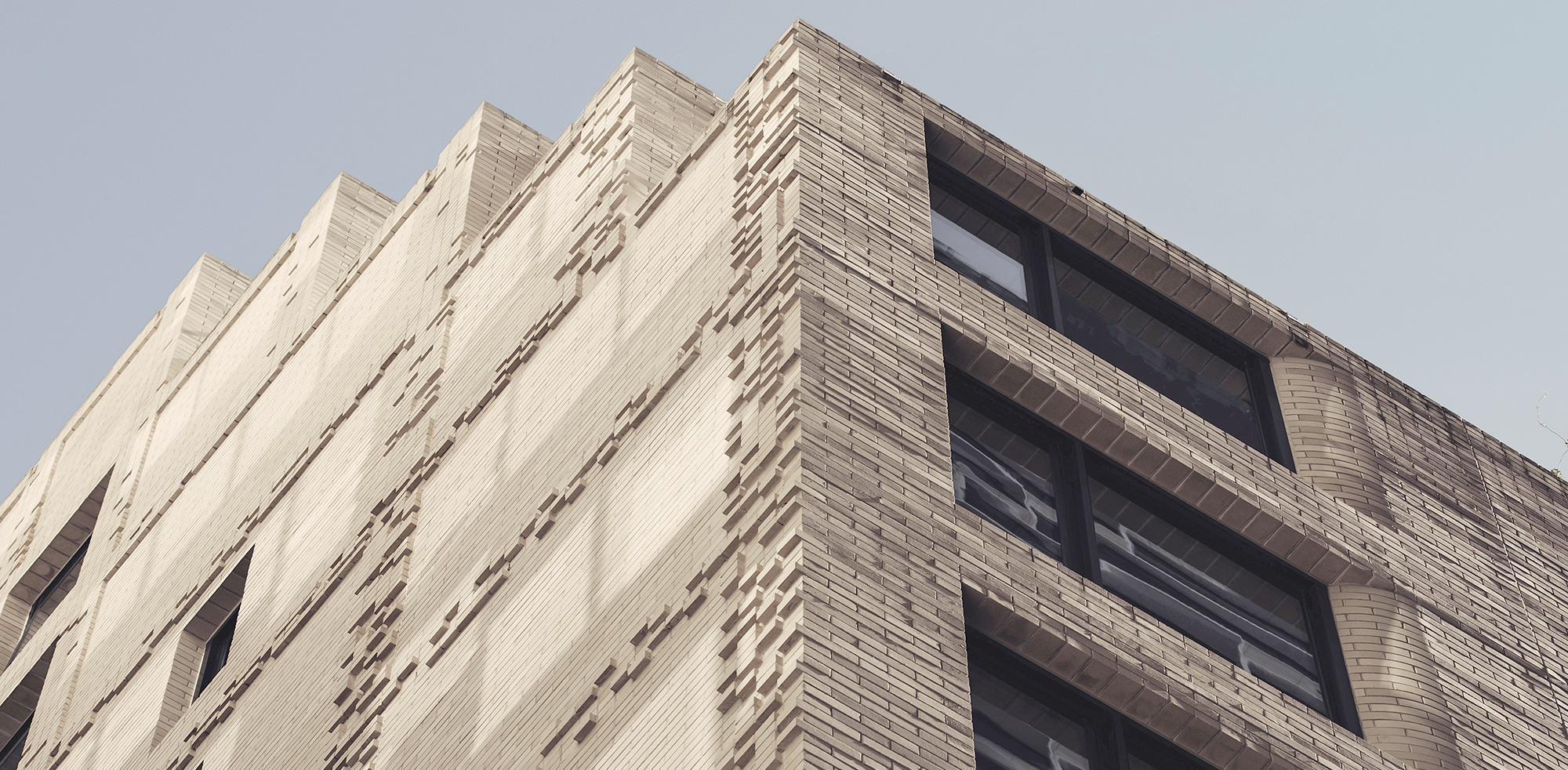Buhl Community Park – After winning a national competition to redesign the plaza in front of the Pittsburgh Children’s Museum ACLA began to work on integrating our design concepts with the physical realities and cultural context of the site. Our iterative process involved close collaboration with the museum staff and public artist Ned Kahn. With the resulting design we hoped to emphasize the importance of community connection, gathering and play.
Architizer chatted with Amir Kunin, Senior Associate at Andrea Cochran Landscape Architecture (ACLA), to learn more about this project.
Architizer: What inspired the initial concept for your design?
Amir Kunin: Our initial concept for the competition drew heavily from the defining natural characteristics of Pittsburgh. Namely the confluence of the Allegheny, Monongahela and Ohio rivers at its center. Our final design could be interpreted as metaphorical rivers flowing diagonally though the square creating a large gathering space and stage for public art where they meet. Our intention was for the park to act as a fulcrum supporting the intersection of past and present, industry and ecology, art and the urban landscape.

© Andrea Cochran Landscape Architecture
What do you believe is the most unique or ‘standout’ component of the project?
The integration of the dynamic sculptural element – Cloud Arbor – within the larger context of the space is an aspect that really stands out for me. The work by Ned Kahn is of a grid of 64 steam emitting 30′ tall stainless steel poles. Its not something that fades into the background and yet it doesn’t feel overbearing in the space. Because we worked together from the beginning the plaza feels like it was made for the sculpture and visa versa.

© Andrea Cochran Landscape Architecture
What was the greatest design challenge you faced during the project, and how did you navigate it?
This is a bit technical and possibly boring but the relationship between the grid layout of the sculpture poles and the pavers below was a complex design challenge that tested the limits of my high school level mathematics.
The sculpture grid is rotated so it’s not orthogonal or at 45 degrees to the paver pattern. To ensure the poles all land at a mid point of the joint in the pavers and that they are equally spaced in the north south direction we had to rotate the sculpture grid (26.565 degrees) from orthogonal and use custom size precast concrete pavers. The pavers which turned out beautifully were made by a local Pittsburg company called Sun Precast.
Note: The pavers surrounding the sculpture are pedestal supported to make room for all of the mechanical infrastructure and to allow water from the condensed steam vapor to drain below.


How did the context of your project — environmental, social or cultural — influence your design?
All of these contextual elements played an important role in our design process. As I mentioned earlier the natural environment of Pittsburgh’s rivers were an important foundational concept for the design. Plants and trees were selected based on their being native to the Allegheny region. The connection to the Children’s Museum reminded us that an element of play or whimsy was a critical aspect of the social context. The cultural history of Pittsburgh is represented through quotes from some of its most famous citizens etched into the blue stone seat walls.

© Andrea Cochran Landscape Architecture
What drove the selection of materials used in the project?
Materials were selected for their ability to convey the aesthetic intent of our design vision and for their ability to withstand the rigors of a public space in a climate that experiences extreme seasonal temperature changes. Most of our offices work is in our home state of California so learning about and detailing to accommodate freeze/ thaw conditions was a new experience. Where possible we used locally sourced materials.

© Andrea Cochran Landscape Architecture
What is your favorite detail in the project and why?
I’m going to have to return to the relationship between the custom precast concrete pedestal pavers and the grid layout of the art installation poles and in-grade up lights as my favorite detail. This is the one that gave me the most stress and eventually satisfaction. The engraved quotes from famous citizens of Pittsburgh on the bluestone seat walls is also a favorite. Its subtle but once you notice one it’s a little like a treasure hunt to discover the others.
How important was sustainability as a design criteria as you worked on this project?
The design of a native riparian habitat bio swale to treat storm water and the use of native plant material throughout the project was an important sustainability measure to make the design feel geographically grounded . We worked closely with a soil scientist to ensure the imported topsoil was prepared specifically for the needs of the native plants using only organic amendments and fertilizers.

© Andrea Cochran Landscape Architecture
In what ways did you collaborate with others, and how did that add value to the project?
Our main collaborators in the design process were the our clients at the Children’s museum of Pittsburgh (Executive Director Jane Werner and Deputy Director Chris Siefert) and the public artist Ned Kahn. Because of the open communication throughout the process we were able to ensure that the program requirements and concerns of the Museum were accommodated and the sculptural element was fully integrated as the design evolved from competition entry renderings to being constructed.

© Andrea Cochran Landscape Architecture
Were any parts of the project dramatically altered from conception to construction, and if so, why?
Our initial competition entry showed circulation pathways were a much more literal interpretation of the river concept with flowing curved edges and pier like structures extending over them. Once the design became a more linear distilled abstraction of the river concept in the schematic design phase connections to the existing streetscape and surrounding community were noticeably enhanced. The essence of the design remained essentially enact through construction.

© Andrea Cochran Landscape Architecture
How have your clients responded to the finished project?
The park has been completed since 2012 and the initial reaction from the clients and community was resoundingly positive. Below is the description from the Children’s Museum of Pittsburg website today.
“The park makes the neighborhood significantly greener with the introduction of more than 100 trees, 200 shrubs and 5,000 perennials, and a reduction in concrete surfacing from 89% to 37%. Since opening, the Park has become a central location for community gatherings, neighborhood dog walks, lunch time concerts and private events.”
As landscape architects we couldn’t be happier with the way the park has been embraced by the community.

© Andrea Cochran Landscape Architecture
What key lesson did you learn in the process of conceiving the project?
For me this project reiterated the value of the collaborative design process. This project was not the grand vision of an individual or firm but rather an ongoing conversation between our office and Children’s Museum, Ned Kahn and the community surrounding the park.
How do you believe this project represents you or your firm as a whole?
At ACLA we aspire to create experiences that seamlessly integrate landscape, art and architecture while responding to the specific needs of the client and the existing environmental conditions. I think this is a project that is successful in meeting many of those goals.

© Andrea Cochran Landscape Architecture
How do you imagine this project influencing your work in the future?
This project was completed in 2011 so 11 years later I can look back on this project as an important step in my personal development as a designer. Helping to manage a project with a large team of consultants was a new experience and one that gave me a greater appreciation for much of the work (civil & structural engineering) that goes unseen once construction is complete. I certainly pause a little longer these days to contemplate the constructibility of a detail before I get too far ahead of myself in the design process.

© Andrea Cochran Landscape Architecture
Team Members
Andrea Cochran Principal, Jennifer Knott Project Manager, Amir Kunin, Designer
Consultants
Design Team: Public Artist: Ned Kahn Civil Engineer/MEP: Stantec (Formerly Burt Hill – Pittsburgh) Structural Engineer: Atlantic Engineering Services Client Team: Children’s Museum of Pittsburgh: Jane Werner, Executive Director Children’s Museum of Pittsburgh: Chris Siefert, Deputy Director Children’s Museum of Pittsburgh: Vickie Watson, Project Coordinator Program Consultant: Dennis McCarthy Construction Team: General Contractor: P.J. Dick Landscape Contractor: Butler Landscaping Paving and Stone Contractor: Harris Masonry Misting System Design/Build: KoolFog
Products / Materials
Landscape Forms for Site Furnishings. Sun Precast Co Inc. for the Precast concrete elements
For more on Buhl Community Park, please visit the in-depth project page on Architizer.










 Buhl Community Park
Buhl Community Park 


